The Ultimate Guide To Motorbiking The Entire Length Of Vietnam (1600+ km)
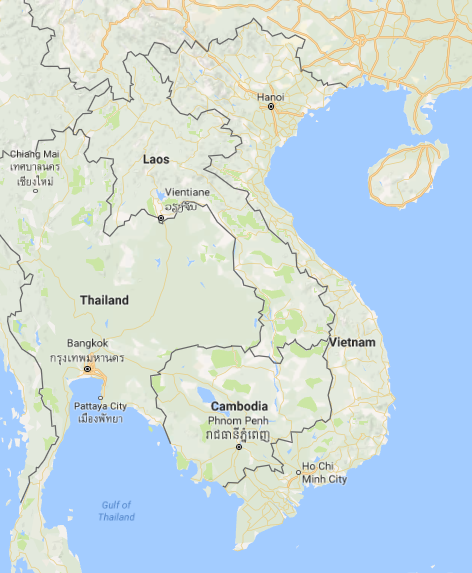
Vietnam’s geographical shape - long and narrow for the most part - lends itself perfectly to a linear or slightly non-linear route from one end of the country to the other.
For many adventurous travellers, the vehicle of choice for completing this epic journey is a motorcycle, not only because of the country's shape but for a number of other important reasons.
First of all, many people were initially inspired by the 2008 Top Gear Vietnam special series, in which Richard and Clarkson motorbiked approximately 1,000 miles from Ho Chi Minh city (Saigon) in the South to Halong city in the North. The men completed that journey in just eight days and the idea has diffused a lot throughout the western world since then.
Another reason why a motorcycle trip is so popular in Vietnam is that public transport is poorly developed in the country and motorcycles have become the solution of choice for getting around, both for local Vietnamese residents and for many foreign tourists.
Petrol and repairs are also relatively inexpensive and a decent second-hand bike can usually be bought for less than $250. The Vietnamese police aren't usually too interested in foreigners touring the country on motorcycles either, especially if they keep a low profile.
Touring the country by motorcycle is therefore the ideal way to explore it; that is if you can first summon the courage to ride a motorcycle on Vietnam's often dangerous and seemingly rule-less roads.
If you've never rode a motorcycle or scooter before, the task will understandably be even more daunting and you'll have to overcome a fairly steep learning curve at the beginning.
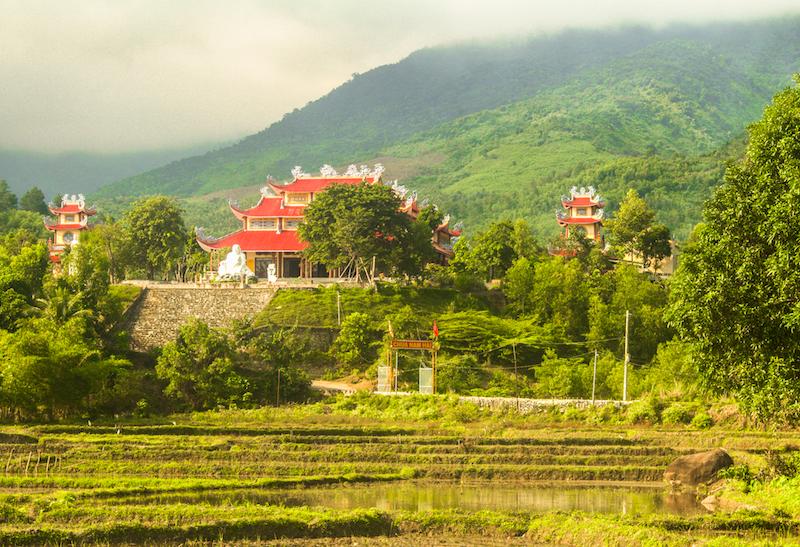
Most foreign tourists who undertake a motorbike trip in Vietnam will begin their journey from either Hanoi city in the North or from Ho Chi Minh city (Saigon) in the South and attempt to travel the formidable distance between the two cities.
Perhaps some 15-20 travellers set out every day to attempt to motorbike from one of these two cities to the other.
Some of these travellers will quit before completing the journey, lacking either the time or the willpower to finish it.
Some will have a minor accident or two that aren't discouraging enough to stop them from completing the journey.
The most unlucky travellers will have a more serious accident that will bring an abrupt end to their dream of completing a tour of the country by motorcycle. These travellers may even have to be evacuated to their home country for medical treatment.
Most people who attempt this however will complete the journey relatively unscathed (we assume).
If you are a complete beginner, we advise you to try to find somewhere that's relatively traffic-free in Ho Chi Minh or Hanoi and have a few practice sessions, rather than diving straight into the deep-end and risking an accident.
How much distance do I need to cover?
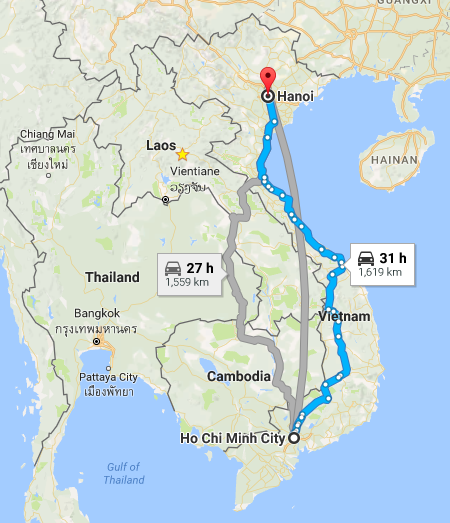
What Vietnam lacks in width, it certainly makes up for in length. The distance between Hanoi and Ho Chi Minh city is about 1136 km as the crow flies.
However, you have to remember that you’re not a bird with wings and you will be travelling by road, which will make the journey longer. You’ll probably also be making several detours to various attractions and interesting destinations along the way.
Expect to cover an absolute minimum distance of 1,619km, using the shortest route possible and making no detours from the main highway.
How long will the journey take?
We recommend allowing one month or more for completing the trip. Some people complete the trip in only 10 days or less but they spend almost the entire trip doing nothing except driving the bike.
We advise you to take your time and spend three or four days in each destination that you like along the way. Once you've made made a good connection with each worthwhile stopover, you can take on the next leg of the journey.
The journey can be broken down into 100km or 200km segments, as was the way that we approached it, but driving much more than 200 km in a single day is an arduous and mentally draining affair.
This is because the Vietnamese roads are generally in poor condition and average speeds of 30-40 km/hr are about all you can hope to achieve. The dangerous and unpredictable pothole-ridden roads also mean that you have to concentrate quite hard while driving, which makes it all the more exhausting when driving for long periods of time. It could easily take you 7 hours or more to cover 200km on any given section of the route.
How much should I budget for the journey?
If you’re a budget traveller like us and you travel with a partner, you can do this trip on less than $10 per person per day, all-inclusive. If you do the journey solo it could be a little more difficult to stay below $10.
Let’s now break down the daily costs for an imaginary 30 day journey, riding 60 km each day:
Accomodation: $4-6 per day = price per room per night (basic guesthouse)
Food: $4 per day = 3 meals per day @ $1.33 per meal (fish/chicken + rice, local restaurant only)
Petrol: $1.50$ - price for a 60 km trip (approximate cost)
Bike repairs/maintenance: $1-2 per day (on average)
If you’re splitting all of these expenses with a travel partner (all costs can be split except perhaps food costs), the minimum cost for the trip will be around 7-8$ per person per day. This was in fact our average daily cost when we calculated it afterwards.
However, if you start adding in beer, dining in fancy tourist restaurants, going on tours, staying in expensive hotels with a/c and so on, then the daily cost could soar a lot higher than this bare minimum.
Note that, if you really rushed the trip, drove to a new destination every day and finished in say 15 days, your average daily expenses would be higher (due to higher daily petrol and repair costs) but your overall expenditure for the trip would be lower (due to less total days spent travelling).
Where Do I Buy A Motorbike?
You’ll first need to decide on how you’re going to tackle this, either starting in the north and heading south, or starting in the south and heading north.
In Hanoi in the North, Vietnam's capital city, there are plenty of bikes on sale at any given time, meaning that you have the upper hand when buying a bike here due to the high competition. But how about selling the bike when reach Ho Chi Minh city in the South? Well, it turns out that there's a shortage of bikes for sales in Ho Chi Minh, so you will actually have the upper hand selling the bike there.
Starting in Ho Chi Minh, you're at a disadvantage buying a bike due to the scarcity and then arriving in Hanoi you're also at a disadvantage trying to sell the bike with tons of competition.
It makes more sense economically therefore to do the journey from Hanoi to Ho Chi Minh. However, doing it that way won't be practical for everybody so we will detail where to look when buying a bike in both cities.
If you begin in Hanoi, you’ll mostly find a lot of Honda Wins (a type of manual motorcycle) and maybe a few semi-automatic and automatic Hondas & Yamahas for sale in the Old Quarter area.
Take a stroll along Ma May street, Dao Tuy Tu street and other parallel streets and keep an eye out for motorbikes on sale. Visit the Central Backpackers Hostel and other popular backpacker hostels around here and check out their notice boards for bike-for-sale ads.
Beginning in Ho Chi Minh city where bikes are a little scarcer, your best bet is to look around the main backpacker/tourist enclave around Pham Ngu Lao street. Take a stroll along Pham Ngu Lao and Bui Vien streets and look out for motorbikes on sale. Ask local people and they’ll assist you in finding a bike for sale. We looked at several bikes in Saigon and found them to be mostly priced in the 230-300$ range.
Who Should I Buy The Motorcyle From?
Whether you find a bike that you’re interested in online (Vietnam.craigslist.org) is good) or while exploring the streets on foot, you’ll be buying either from a local Vietnamese dealer or from another traveller/backpacker. Let’s look at the advantages and disadvantages of each.
A backpacker trying to sell a bike to you is likely to have driven the bike a long way, possibly all the way from Ho Chi Minh City or Hanoi. Some backpackers only do the bare minimum of repairs and maintenance work on the bike necessary to get it across the country in one piece and therefore you should watch out for bikes that are in bad condition after the long journey. Most backpackers are fairly decent people though and should be fairly trustworthy.
Another advantage with buying from backpackers is that many of them are desperate to sell their bikes, due to time constraints or their visas being about to expire, so you might get a ridiculously low price if you meet somebody in such a predicament. We in fact encountered one such time-strapped fellow who was offering his bike for a price of just 40$.
Local dealers will usually give second-hand bikes at least a rudimentary servicing before selling them to travellers so these can usually be a reliable place to purchase a bike from. They’ll have invested some money in restoring the bike to a decent condition, so you won’t get the cheapest possible price here, but you’ll get something that’s fairly reliable.
Beware however of con-artists, who pretend to be working for reputable companies. They might even hand you a business card and claim to be working for the company on the card.
These scammers will usually try to sell you a very old and dilapidated bike worth 80$ for 300$ and will lie to you about having serviced the bike and replaced all the old parts.
They may also tell you that their company will buy back the bike for a good price in the destination city, but when the backpacker finally arrives, he finds that the company can only offer him maybe $100 for the bike that he bought for $300 and moreover that they have no idea who the person is that claimed to be working on their behalf.
Our advice is to take a look at a few different bikes, sold by both backpackers and local dealers, compare the prices and the condition of the bikes and then make your final decision.
What type of motorcycle is best for the trip?
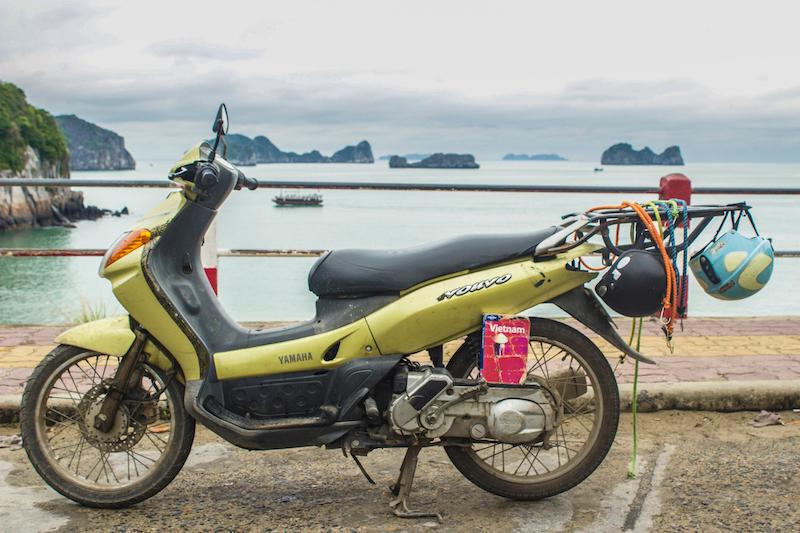
We’re not motorcycle experts but we have made a few observations from our dozens of experiences driving different types of motorbikes in Southeast Asia and we’ve done a little research into this topic as well.
Okay, so you’ll be looking at three different types of bike to choose between and they are: automatic, semi-automatic and manual bikes. Let's take a look at the advantages and disadvantages of each.
Automatic bikes
Automatic bikes use a system of front and rear pulleys to regulate the torque on the wheel. The number of gears are almost infinite and the gears change automatically according to the speed of the bike.
Advantages:
Automatic bikes are convenient for beginners who don’t want the extra hassle of learning how to operate the gears of a manual or semi-automatic bike. All you have to do is manage the throttle, the steering and the brakes. On the often chaotic and dangerous roads of Vietnam, having one less thing to think about could be a bonus.
A second advantage is the ability to blend in with this type of bike. A lot of the locals go around on automatics or semi-automatic scooters so you’ll attract less attention from the police if you drive one of these. This will reduce your chances of getting fined or questioned by the police.
A third advantage is that these bikes usually have a compartment under the seat where you can store a small bag, bungee cords, helmets, groceries or whatever.
Disadvantages:
Automatic bikes are inefficient and tend to consume more petrol than semi-automatics and manual bikes. Petrol isn’t very expensive in Vietnam but costs can add up.
Example: Yamaha Nouvo 125cc
Semi-Automatic bikes
Semi-automatic bikes differ from automatic bikes in that they essentially use a manual gearbox, with an automatic clutch mechanism. The driver has only to release the throttle in order to change the gears by the operation of a foot pedal.
Advantages:
Semi automatic bikes are a kind of compromise between automatic and manual bikes. They try to offer the efficiency benefits of a manual bike, while demanding a little less input from the driver. We’ve noticed that they definitely consume less petrol than automatic bikes.
Like the automatic bikes, these are also great for blending in because local people will be mostly either riding these or automatic bikes.
They also usually have a storage compartment underneath the seat like most Automatic bikes.
Disadvantages:
There are no major disadvantages with semi-automatic bikes that we're aware of. One minor issue we've had with them is that the gears can sometimes be a bit unresponsive to changing when you press on the foot lever.
Example: Honda Wave 110cc.
Manual bikes
Advantages:
Manual bikes allow for efficient transfer of the energy from the engine to the wheel, reducing fuel consumption costs considerably. Some people might just like the ‘feel’ of manual bikes, which make them feel like a real biker dude.
Disadvantages:
Handling is more complex and there's a steeper learning curve involved in learning to ride manual bikes. They require regular maintenance in looking after the chain, making sure it’s well oiled and tensioned. They also tend to lack that handy compartment under the seat that the autos and semi-autos have.
Riding a manual bike in Vietnam also comes with the disadvantage of making you stand out like a sore thumb as a foreign tourist. This could attract more attention from the police and give you a few problems.
For example, while touring the country on our motorcycle, we met two American men riding manual Honda Win bikes and they told us that they had been stopped by the police several times during their journey, which proved very costly for them in paying fines. On the other hand, we were only stopped once at a deliberate trap in Mui Ne and pretty much ignored by the police all the other times on our Yamaha Nouvo automatic bike.
Another problem with choosing a manual bike in Vietnam is that that normally means you're buying a Chinese knock-off of a Honda Win. Honda stopped making this bike in 2000 and the Chinese then copied it. The fake Honda Wins that people buy in Vietnam have also usually had their engine and other parts completely replaced with cheap second-hand parts. The bikes can then occasionally fall apart during the journey as a result, which can be extremely hazardous and could cause a serious accident.
Our Advice
Our recommendation would be to buy a semi-automatic bike. The most common semi-automatic bikes in Vietnam seem to be the Honda Wave models, so you might consider testing one of those.
Although we made our journey with an automatic bike, we would probably choose a semi-automatic bike if we were to make the journey again.
Remember, a semi-automatic bike will allow you to blend in a lot better than a manual bike will, helping you to avoid attention from the police. They’re also not too difficult for a beginner to get the hang of and they consume less gasoline than their automatic counterparts, thus saving you money.
What else should I be looking for when choosing a motorycle?
Other than deciding on the type of motorcycle, you should also take into account the price, the horsepower and the condition of the bike.
Price
Look for a bike that suits your budget. Most bikes for sale will be in the 200-300$ range but a few bikes will be pricier than that. Before you decide to inspect a bike, you should first ask the price. If the seller starts at a reasonable price like 250$, you should try to bargain it down lower. If the owner won’t budge on the initial price, you can try bargaining again after inspecting the bike. Walking away can also sometimes work wonders.
Horsepower
If you’re a really big or heavy person and you plan to travel through the central highlands, then you’ll need to make sure you buy a bike with enough horsepower to get you up some of the steeper hills. You won't be always be able to make use of extra horsepower in Vietnam however, because the often poorly maintained roads will impose very modest speed limits upon you as a driver.
Take into account the total weight you’ll be transporting, including all of your baggage. A 125cc bike should be powerful enough even for bigger folks, including a reasonable amount of luggage.
We took a 125cc bike all the way through the mountains (Central Highlands) without any problems, carrying the two of us and about 30kg of luggage. The total load was about 150kg. We were perhaps a little overloaded but we had no problems, even on the steeper hills.
Bike condition
To make sure you don’t get scammed or ripped off, it’s critical that you inspect every bike that interests you before making the final purchase.
You’ll want to first glance over it and make sure there’s nothing obviously amiss. Make sure it has two working mirrors, the body is in reasonable condition and nothing is obviously loose or hanging from the bike. Loose parts are not a good sign.
Okay, now it’s time to take the bike for a test drive. During the test drive you’re looking for the bike to inspect the following:
Electric starter:
Insert, then turn the key in the ignition and make sure the electric starter is working. The engine should start up quickly without any major delay.
Lights
Check that the lights are working, both high and low beam. Check that the brake light is working also.
Horn
Make sure the horn is working because you’ll need to use it on a daily basis. This can make the difference between a collision and a narrow miss.
Gauges
Check that the fuel gauge is working ( the needle should move if there’s any petrol in the engine). Don’t worry too much about the speedometer/odometer because these are usually broken on second-hand bikes anyway and most mechanics won’t know how to fix them.
Tyres
Tyres are extremely important. Make sure the tyre treads are deep and not too worn down. Shallow tyre treads are dangerous, giving reduced traction and also causing frequent punctures, costing you a fortune in replacing inner tubes.
Brakes
Test the brakes to make sure they’re working properly and see that you can stop quickly if you need to. You likely will need to make a few hard stops during your journey. Properly working brakes are extremely important for avoiding accidents.
Kickstart
The kickstart is an important backup to the electric starter, since the electric starters are prone to malfunctioning. Turn off the engine and test the kickstart and make sure that it’s working. It shouldn’t take you more than a few foot pumps to fire up the engine.
Engine
As you drive around, listen to the sound of the engine. It should have a pleasant hum without sounding too loud or odd.
Gears
If you’re testing an automatic bike and hear any squeaking sounds from the gearbox, this is a major red flag. If it’s a semi or manual bike, go up and down through the gears and make sure they shift smoothly without sticking.
Now you must remember that if all these things are initially in working order, it does not guarantee that your journey will be problem free. However, it does at least guarantee that you’ll begin the journey with a bike that works properly.
The next step is to ask the owner about the history of the bike. Ask him/her what repairs or changes were made to the bike recently. Ask if there are any issues with the engine or gearbox. Ask as many questions as you need to ask to feel confident about deciding on a purchase.
Lastly, bargain, bargain, bargain. Don’t be afraid to ask for the price that you want. Be patient, compare several potential bikes and wait for the right bike and right price to come along. When these two things coincide, then you are finally ready to make your purchase.
How do I strap my luggage to the motorcycle?
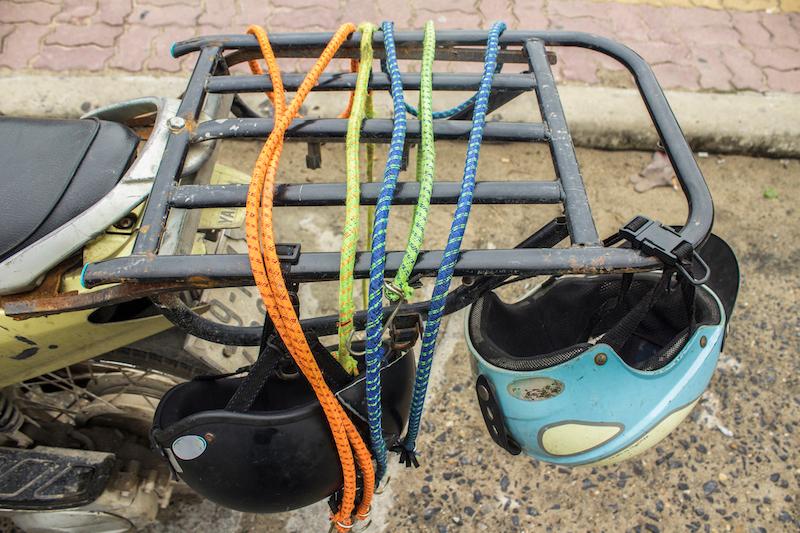
If you’re carrying luggage like a large backpack you’ll probably want to have a luggage rack fitted to the bike. See the photo above for how the rack is fitted to the bike.
If you buy the bike from a backpacker, it’ll probably already have one fitted as most backpackers strap their bag to a luggage rack. If you buy a bike without a luggage rack, just take it to a mechanic and ask to have one fitted for an extra 10$ or so, or just ask the original owner to fit one for you before you purchase it.
You can secure your bag to the rack with bungee cords and two are usually enough to secure it tightly. Some people also just strap the bag directly to the free seat space behind them if they’re travelling without a second passenger. This strategy can work really well and negate the need for having a luggage rack fitted.
On some types of scooter, there’s also a space to fit a bag inside the well where your feet sit as you drive the bike. You can strap another bag here with bungee cords if you have two bags to carry and we found this setup worked better than carrying two bags stacked vertically on our luggage rack (this arrangement raised the bike’s centre of gravity considerably and made the bike feel alarmingly unstable).
A word of caution: Make sure a really good and professional welding job is done on the luggage rack. A half-hearted welding job will cause the rack to inevitably fail under the weight of your continuously bouncing luggage, likely at some inconvenient time during your trip. Any weaknesses in this department will soon become apparent, trust us on this one.
What else do I need to bring?
Other than your luggage and the bike keys, there are a few other things you should bring with you on your Vietnam motorcycle road trip.
Blue registration card:
This is normally a small, laminated, blue card and you’ll need to obtain this from the owner of the bike. It contains information like a serial number, the bike model and the name of the original owner. If you don't carry this card with you, you risk having the bike impounded.
The number on the card should match the license plate on the bike and you should confirm this. The blue card is also very important to have if you want to have an easy time selling the bike at a later date.
Helmets:
Helmets are very important for safety and you could also get fined for being caught not wearing one. Make sure each rider on the bike is always fitted with one.
You’ll usually get a free helmet when you buy a bike in Vietnam but make it's a proper helmet; the "coconutshell" type helmets may be smaller, lighter and more comfortable to wear, but they are less likely to save your life in the event of a serious accident.
Maps:
Try to find one or two good road maps. This will help to avoid getting lost, which can happen easily in a country as large as Vietnam. You can't always rely on mobile phone apps because batteries can die half-way through a journey.
Sometimes backpackers will give you a free map when you buy the bike from them, but you can also find good maps of Vietnam for sale in the two major cities. Check travel agents for maps or sometimes you’ll find them being sold to tourists by street sellers.
Ponchos:
Bring a few plastic ponchos to throw over yourself and your bag(s) if it starts raining. These work very well and you can drive through rain for hours without getting too badly soaked. Purchase them from shops or street sellers for maybe under 1$ each. We were lucky and hardly met the rain at all but you never know, especially in the mountains.
Gloves:
They’re useful to protect your hands from sunburn as the sun can beat down on you relentlessly as you’re driving. They’ll also help protect against developing hand blisters if you're driving for several hours. It can get cold in Vietnam too, especially in the North during the winter months so gloves will also help prevent your hands from going numb during cold, wet weather.
Dust mask:
This is useful to help you blend in with the locals and also to reduce the amount of fumes and dust that you’re breathing in. Large vehicles driving in front of you can kick up a tremendous amount of dust and you might not always be able to overtake them immediately.
Protective clothing:
It’s important at the very minimum to wear long pants and a long sleeve sweater to give yourself a little added protection in the event of a fall or a skid. The grazes and injuries will be worse if you have an accident wearing just a t-shirt and a pair of shorts. Consider also buying knee pads and elbow pads to give extra protection to those vulnerable areas in the event of an accident.
The sun in Vietnam is not to be underestimated and if your skin is somewhat fair, you will get badly sunburned in just a few hours of driving if your skin is not covered.
Eye protection:
We don’t have any experience with using eye protection because we prefer to have our vision completely free and unimpeded when we’re driving. Sometimes though, flying insects can be a problem, especially at night or around sunset. They get attracted to the headlights of the bike and sometimes collide with your face or eyes, which can be a little unnerving.
If it's a concern for you then the best solution is probably to make sure your helmet has a transparent visor, which you can pull down when the dust or insects get out of control.
What route should I take?
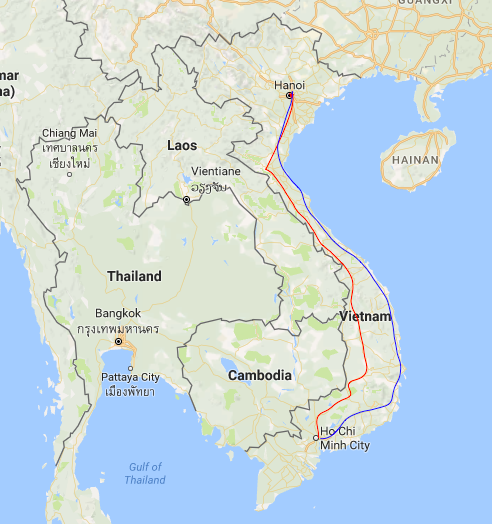
There are two major routes running in a north-south direction in Vietnam; the main artery of the country known as Highway 1 and the more inland and picturesque Ho-Chi Minh road.
The Ho Chi Minh road is a lot more scenic and takes in some truly spectacular karst landscapes and mountain scenery along the way.
The Ho Chi Minh road is also a lot quieter than highway 1, with less traffic. It’s currently a two-lane road but more lanes may be added in the future. You could drive the entire distance between Ho Chi Minh and Hanoi on this road, if you so desire to avoid the coastal areas and major tourist attractions. The total distance covered in that case would be about 1,880km.
Highway 1 is busy, dangerous and mostly passes through developed areas, with very little respite from the chaos. However, it does pass through a lot of the major tourist hotspots and attractive coastal areas. You’ll be inevitably riding on this for at least part of the journey if you’re at all interested in seeing any of the major tourist destinations in Vietnam.
As for us, we spent the greater part of our journey on the Ho Chi Minh road but we did make several detours to coastal attractions during the trip, so we didn't drive this route in its entirety. Just know that you don't have to be a slave to one of these two main routes. Vietnam's road network allows for more complexity than that. You can and should forge your own route; the one that suits you best.
A brief summary of our trip
We've made a rough outline of the route that we took, starting from Ho Chi Minh city in the South and ending at Hanoi in the North. We spent parts of the trip on Highway 1 and other parts on the Ho Chi Minh highway so your trip doesn't necessarily have to be either or.
We've divided up our route into three maps, one for the southern part of the country, one for the midsection and one for the North. On each map we've marked the cities and towns where we stayed at least one night in a guesthouse or homestay.
The green line represents the approximate route we took. In reality however, the route is a lot more complicated than these maps might suggest.
Map 1 - The South
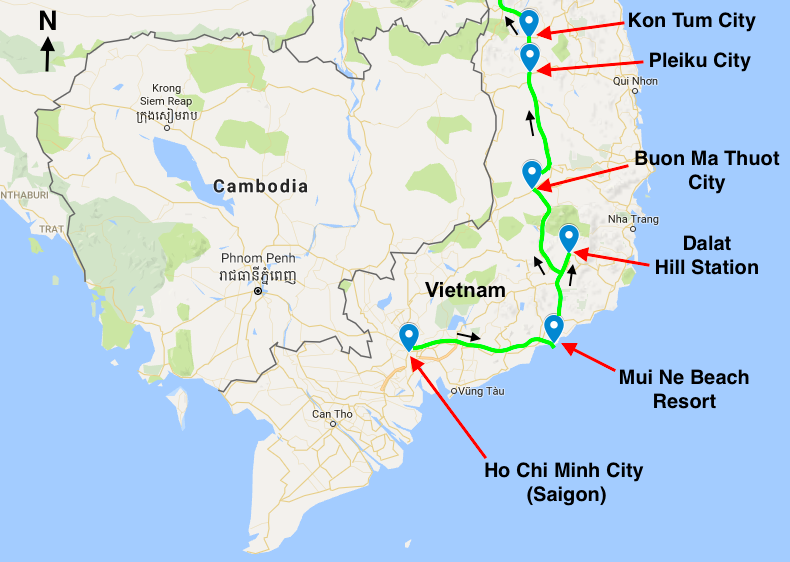
Map 2 - The midsection
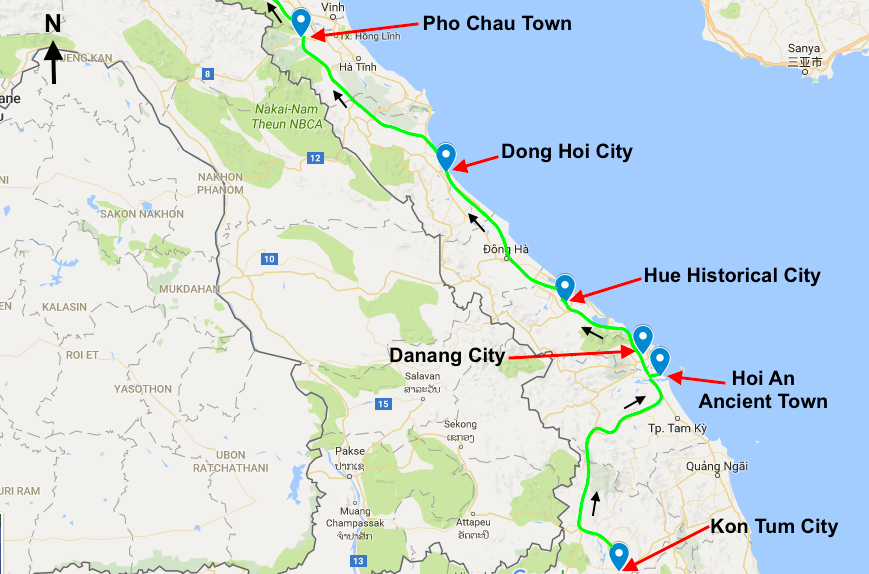
Map 3 - The North
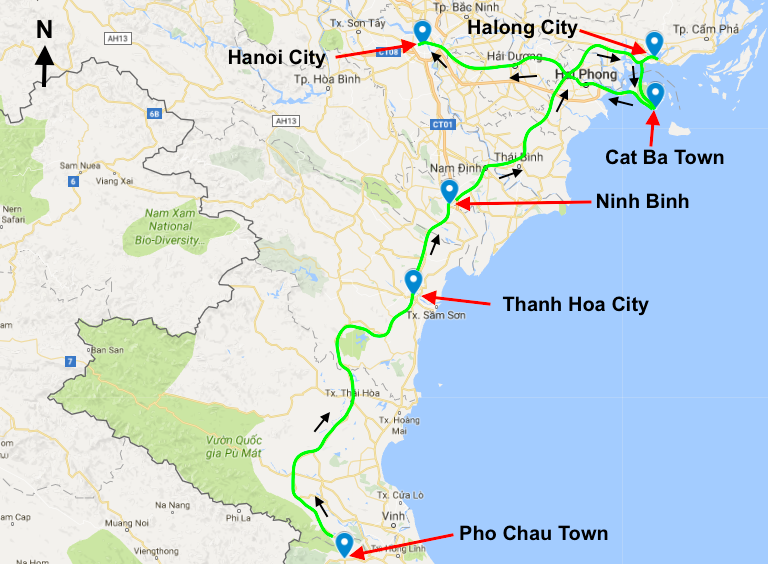
We took our time travelling the long route between Ho Chi Minh city and Hanoi, taking 59 days to complete the journey.
As you can see from the map, we overnighted in fifteen different towns/cities, although in Pleiku we had to overnight on the street because we arrived so late at night that no hotels or guesthouses were open! Our shortest stay in any given place was one night (Pleiku, Pho Chao, Thanh Hoa) and our longest stay was 10 days in Hoi An. The average number of days we stayed in a destination was 4.2 days.
Our route went as follows: Ho Chi Minh City -> Mui Ne -> Dalat -> Buon Ma Thuot -> Pleiku -> Kon Tum -> Hoi An -> Hue -> Dong Hoi -> Pho Chau -> Thanh Hoa -> Ninh Binh -> Halong Bay -> Cat Ba Town -> Hanoi
Ho Chi Minh City

We began our journey in the chaotic & cosmopolitan Ho Chi Minh city (Saigon), Vietnam's second largest city, which is believed to have more motorbikes than people.
Ho Chi Minh city is all about maddening motorcycle traffic, bustling markets, churches, cathedrals, chinese pagodas, museums, attractive buildings, cafes with fast wifi, street food and decent nightlife. The city also has a few high-rise buildings and rooftop bars. There's a zoo where the animals aren't treated very well.
The main backpacker area is around Pham Ngu Lao Street, where you'll find all the cheap accommodation, affordable restaurants and watering holes.
Mui Ne Beach Resort
.jpg)
From Ho Chi Minh city, we headed 216km east to the exotic beach resort of Mui Ne, known for its spectacular red and white sand dunes, miniature canyon, kitesurfing and other watersports, picturesque fishing harbour, delicious seafood and of course its sandy beaches. It even has three ruined Cham towers dating back centuries, on a hilltop not far from the main beach.
Although Mui Ne has become very touristy in recent years, this was still one of the most inspiring destinations that we visited in all of Vietnam. We've written a full travel guide to Mui Ne if you want detailed information about this destination. Don't miss it!
Dalat Hill Station

From Mui Ne we drove 154km north to the famous hill station of Dalat, seated atop a plateau at 1,500 metres above sea level (4,900 ft). Long before reaching the city itself, the air became cooler, fresher and filled with the scent of pine trees. It was after dark when we knew we had finally reached Dalat, as we could see the welcoming sight of the city lights twinkling in the distance.
Dalat is all about its cool climate, fresh pine-scented mountain air, charming pine forests, treks to surrounding mountain peaks, spectacular waterfalls, stunning lakes and reservoirs, cable-car rides, magnificent pagodas, flower displays and beautiful parks and gardens.
Often dubbed the 'Paris of the East', the city has a reputation for being a romantic honeymoon getaway and this is where you'll find all the young lovestruck Vietnamese couples. It even has a miniature Eiffel Tower replica used as a communications tower. In fact, several of the attractions in Dalat cater specifically to this market, especially the so-called 'Valley of Love', set among beautiful pine forests.
In Dalat you'll also find the highly unique Hang Nga Guesthouse, also known as the 'Crazy house' due to its eccentric, unconventional architectural design that resembles a quirky looking tree with its roots flailing in the air around it.
Buon Ma Thuot City
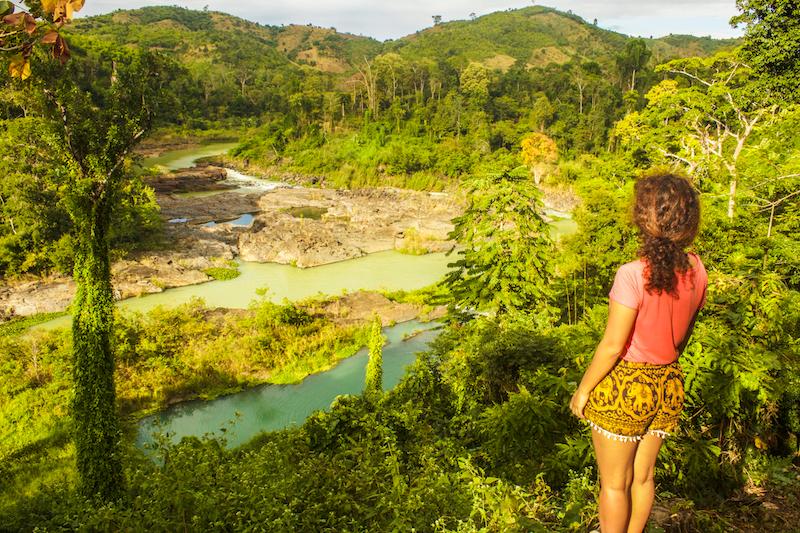
From Dalat, we had a long 210km drive north along winding mountain roads to the city of Buon Ma Thuot, the provincial capital of Dak Lak Province.
Buon Ma Thuot is famous for its coffee and it’s where the majority of Vietnam’s coffee is produced. Vietnam is actually a major world exporter of coffee, second only to Brazil.
We didn’t stop here for the coffee however. There’s an excellent ethnographic museum in the city, which is well worth a visit. Buon Ma Thuot also has two gorgeous waterfalls set in picturesque natural surroundings if you’re prepared to travel out a little from the city.
You can also visit the popular Ban Don village from Buon Ma Thuot, which is now a contrived tourist village to allow visitors to experience the culture of the native minority ethnic groups of the province. In the past it was famous for its strong tradition of elephant hunting and taming. Ban Don is also the gateway to Vietnam’s largest nature reserve, the Yok Don National park, where you can hire a guide to take you trekking.
A little further afield but still reachable from Buon Ma Thout is Lak lake, the largest natural freshwater lake in the Central Highlands, where the indigenous Mnong people still forage and fish in wooden dugout canoes and it’s possible to organize fishing trips, boat trips and waterfall treks.
Pleiku City
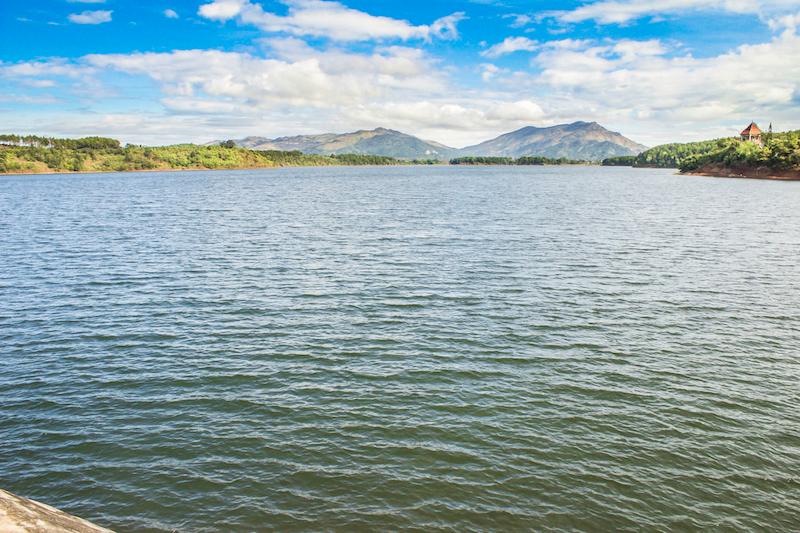
From Buon Ma Thuot we had another long 180km drive through the winding roads of the central highlands, eventually reaching Pleiku city late at night, soon realizing that no hotels or guesthouses were open to accommodate us. We were forced to sleep on the street for the night and the next morning we decided to continue driving North towards Kon Tum.
Pleiku city is the provincial capital of Gia Lai Province, which is known for producing coffee, rubber and hydroelectricity. Pleiku does have one very well known attraction known as Bien Ho or Sea Lake and that’s located en route to Kon Tum, so we decided to stop off there on our way.
The lake lies at an elevation of 900 metres above, is fringed by beautiful pine forests and is overlooked by an observatory. The oval-shaped trough the lake sits in is said to be the crater of a volcano that became extinct millions of years ago. In addition to being a tourist attraction, the lake is an important source of fish and shrimp for feeding the local people.
Not too far away from Pleiku you’ll also find the breathtaking Phu Cuong waterfall, which we didn’t know about during our trip. Visiting ethnic minority groups in Gia Lai Province unfortunately requires you to have a guide and permit, meaning you can’t have a truly authentic experience.
Kon Tum Town
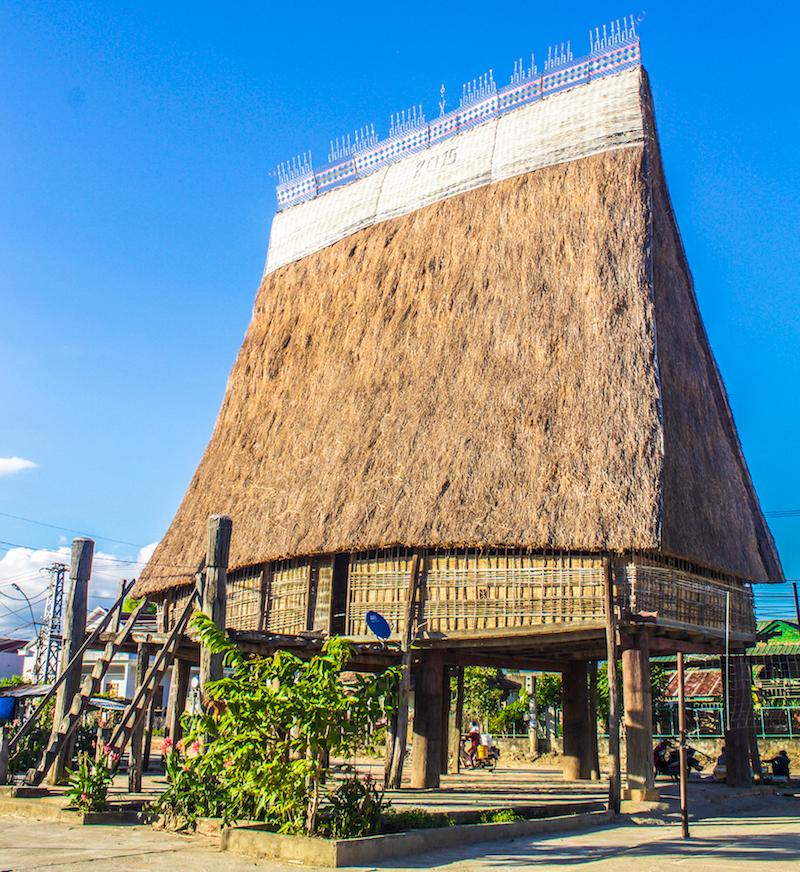
From Pleiku, we only had a short drive of about 48km to Kon Tum town, the provincial capital of Kon Tum Province, which sits on the banks of the Dakbla river.
Kon Tum is renowned for its beautiful Catholic churches, especially its unique 100-year old wooden church, which sits on small stilts and was built by a French priest in 1913. The church is exquisitely designed.
You can also see the beautiful traditional rong houses here, which are only built by the ethnic minority groups around Kon Tum and in a few other regions in the northern highlands. The Rong house has a thatched roof that is pitched at a ridiculously steep angle and is used for communal activities such as meetings, weddings and other ceremonies.
We really enjoyed exploring the traditional villages around Kon Tum on our motorcycle, where the roads get really bumpy and you can get up close and personal with the ethnic minority groups. There were lots of sugarcane fields around the villages that we visited, which are quite beautiful when in flower.
Hoi An Ancient Town
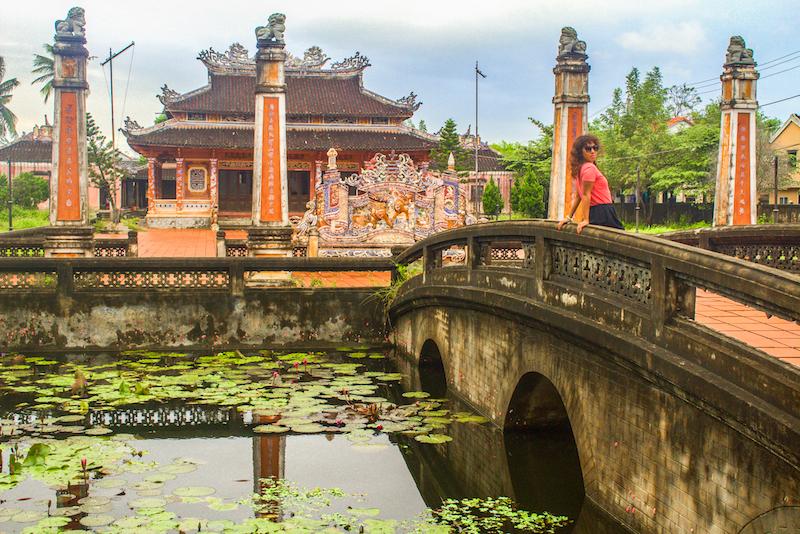
From Kon Tum, we had the longest single drive of our entire journey, a gruelling 280km slog that eventually brought us down out of the mountains, onto Highway 1 and finally to Hoi An, a town that is one of Vietnam’s biggest tourist attractions.
Hoi An is famous for its ancient town, a former trading port with a melting-pot history. The town blends Chinese, French, Vietnamese and Japanese architecture and has been declared a UNESCO World Heritage Centre, which unfortunately means that there’s an entrance fee just to access the old town (which was easily avoidable when we visited).
The atmosphere in the old town is especially magical at night time, when burning candles float down the river in paper lanterns and other glowing handmade silk lanterns of every colour imaginable adorn shops along the streets, making you wonder if this isn’t all just a dream you’re having.
Beyond the old town, you can while away your days here visiting handicraft workshops (lantern-making, pottery, woodcarving, silk-weaving etc.), exploring ancient pagodas, visiting Cam Kim island, cycling around the outlying paddy fields or even relaxing at the nearby An Bang beach, a beautiful sandy strip which is nice for swimming, fishing or sunbathing.
Hoi An is also the ideal base for exploring the My SonCham ruins, remnants of the ancient Cham empire, where you can explore the interesting abandoned and partially ruined Hindu temples among a lush jungle setting.This place is also a UNESCO World Heritage Centre, which means there's an entrance fee that's very difficult to avoid.
Danang City
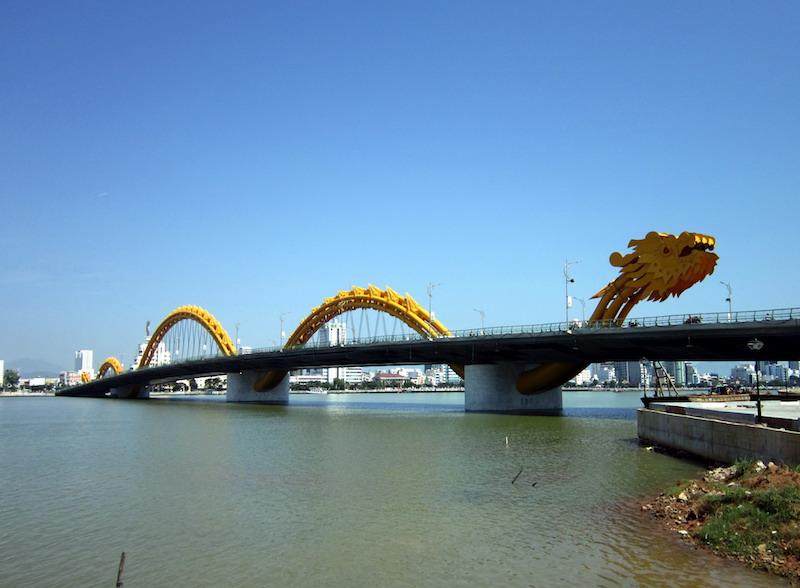
From Hoi An, we drove north to Danang city, a sprawling metropolis of modern high-rise buildings with a small dusting of French-architecture, located right by the seaside.
Although the beaches here seemed quite attractive, Danang was expensive and had zero charm in our opinion, mainly because of all the ugly modern high-rise buildings.
To give it some credit, Danang does boast the 666m long dragon bridge, which spans the Han river and looks spectacular at night, but that wasn’t enough to redeem it in our eyes.
We eventually gave up trying to find a cheap guesthouse in Danang and decided to press on for Hue city, but to get there, we would first we have to drive over the incredibly picturesque and spectacular Hai Van Pass, which was one of the highlights of the entire trip.
Hai Van Pass
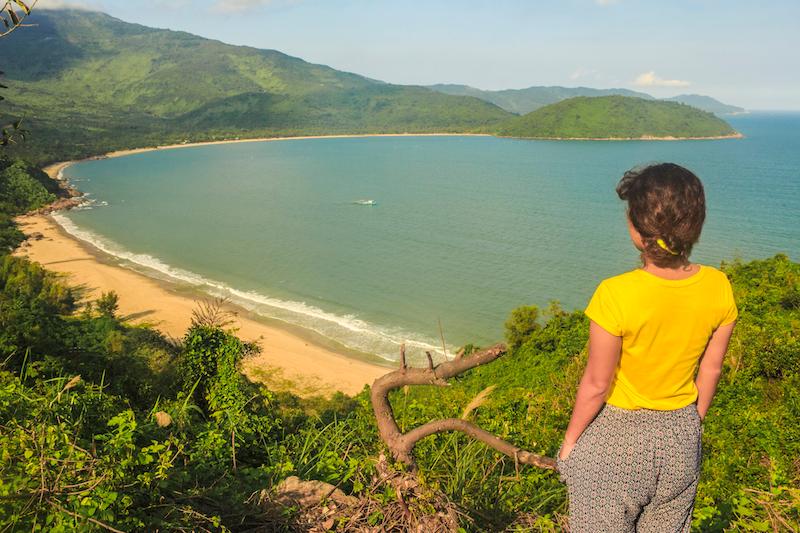
Just north of Danang, a spur of the Annamite mountain range juts out into the South China Sea, forming a natural barrier between the North of Vietnam and the South.
The stretch of road that overcomes this natural obstacle, known as the Hai Van pass, is about 21 kilometres in length and is normally completely deserted apart from a few oil tankers and two-wheelers. The reason for the absence of traffic is a tunnel going directly through the mountain that was built in 2005, which most of the traffic passes through.
We were absolutely enthralled by the drive over the pass, which is definitely one of the most scenic ocean roads in the entire world.
Having ascended the long winding coastal road, we were first rewarded with fabulous sweeping views of the Bay of Danang and later with amazing views of deserted beaches backed by soaring cliffs.
A wonderful view of the Lap An Lagoon was later revealed to us while descending the northern side of the pass. This is a part of the journey that you absolutely must not miss.
Hue City
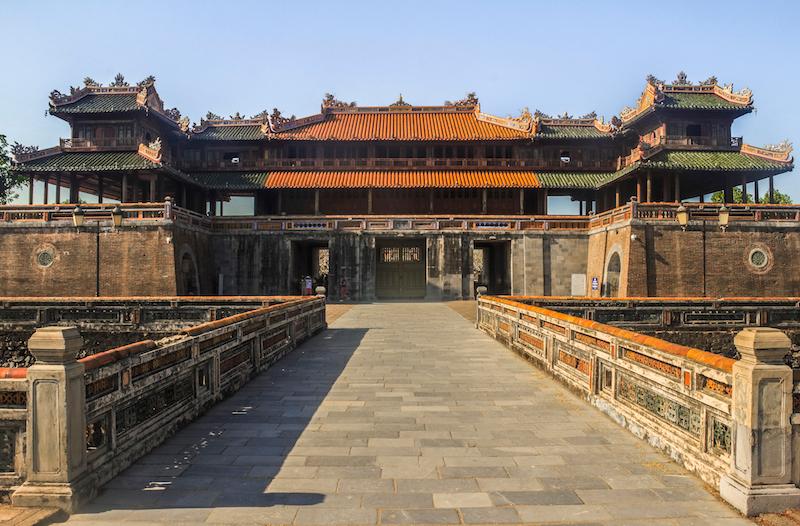
After driving north for 97km from Danang over the Hai Van Pass and beyond, we finally pulled into Hue, a city that lies on the banks of the Perfume River and which was the former imperial capital of Vietnam for a period of about 150 years.
The main attraction in Hue for tourists is the old citadel, which is almost 10km in circumference and is surrounded by a moat and high defensive walls. The citadel dates back to the 19th century and was formerly the seat of the Nguyen Dynasty emperors.
Within the large main citadel, tourists mostly flock to the much more compact imperial citadel, which has a perimeter length of about 2.5km and is also surrounded by a small moat and walls. Within this there are a number of important shrines and palace buildings.
A third citadel is found within the imperial citadel (a citadel within a citadel within a citadel) and is known as the Forbidden Purple City. It’s about 1.2km in circumference and is forbidden because it was formerly reserved for the emperor and his family members.
All the royal buildings are found inside here and there’s also a replica of the royal theatre. It’s a fabulous place to explore with magnificent open courtyards, long hallways lined with ornately decorated red doors, beautiful entrance gateways, shrines, golden dragons and other displays of wealth and extravagance.
Other than the imperial citadel, Hue also features six elaborate tombs for its former ruling emperors, situated along the banks of the Perfume river. Most of the tombs unfortunately do have entrance fees so you probably will want to be choosy.
We didn’t stay long enough to see all of them so we just visited the youngest and best preserved one; the tomb of Khai Dinh. It’s a magnificent creation, with forecourts leading up several flights of steps to the tomb, which is at the very top. Magnificent statues of mandarins, horses and elephants, carved from stone line one of the forecourts on the way up to the elaborately decorated tomb.
Apart from all that, Hue also has several pagodas worth visiting, most notably the Thien Mu pagoda, which was built in 1601 and has seven stories, making it the tallest religious building in Vietnam. The complex also features a giant bell weighing 3,285kg and which is said to be audible from 10km away.
We also enjoyed visiting this one big Vietnamese cemetery in Hue, which was fringed with pine trees. Another place we found notable was Thuy Xuan incense village, where we found hundreds of bamboo incense sticks that had been dyed various colours and had been arranged into beautiful flower patterns to dry in the sun, before being rolled in the incense paste.
Hue also has a covered Japanese footbridge called the Thanh Thoan bridge, worth checking out if you’re interested in architecture. It’s somewhat similar to the Japanese bridge found in Hoi An but without the crowds and entrance fee.
Dong Hoi City
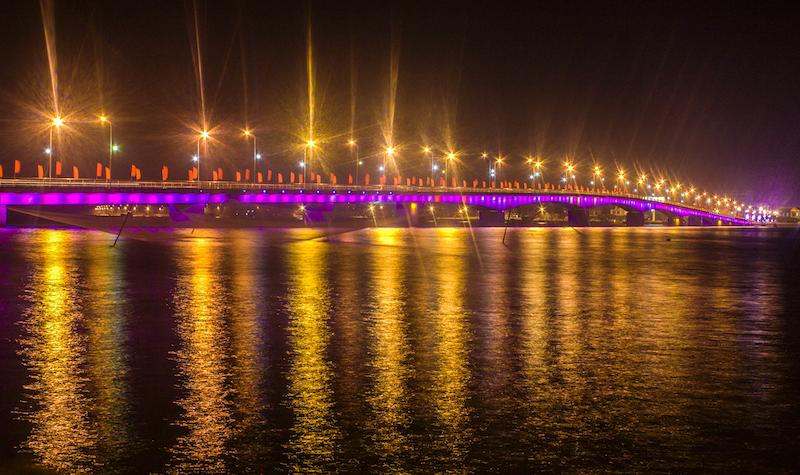
From Hue we powered north along Highway 1 for about 168km until we reached Dong Hoi city, the capital of Quang Binh Province. There isn’t much of interest here apart from the ‘rainbow bridge’ with multi-coloured flashing lights and a few fairly uninspiring local beaches with fishing boats.
However, just 50km away you can visit the Phong Nha-Ke BangNational park, which protects a large part of one of the world’s two largest karst regions. The park covers an area of 857 square kilometres and protects limestone forests which harbor many endangered species. The park is also home to some 300 caves and grottoes, including the phenomenal Son Doong cave, which is believed to be the largest cave in the entire world.
The easiest way to experience the national park is to take the standard tourist boat trip upstream along the Chay river and into the 7,729 metre-long Phong Nha Cave, after which the park is named.
This cave is absolutely phenomenal with enormous caverns and spectacular limestone formations. The river runs the whole way through the cave but the boat only takes you a short distance into the cave. The main entrance cavern is illuminated so that you can see all the stunning formations in great detail.
There are also many other awesome caves that can be explored within the park and several other activities to engage in, including zip-lining, guided trekking in the jungles and swimming in the limestone pools.
Some people also visit the Vinh Moc tunnels from Dong Hoi but at 80km afield, this was too long of a drive for us to bother with. These tunnels were used to shelter villagers (about 90 families) from unremitting bombings during the Vietnam War. The tunnels had three levels and ran for a distance of about 2km, allowing the village to continue operating as normal underground as bombs continuously rained down aboveground.
Pho Chau Town
From Dong Hoi, we drove 223km to a small crossroads town called Pho Chau, driving along the Ho Chi Minh road for much of the journey. We reached the town after dark and found a cheap homestay. This was literally just an overnight stop, since we hadn’t read anywhere about there being anything interesting to do in Pho Chau.
Thanh Hoa City
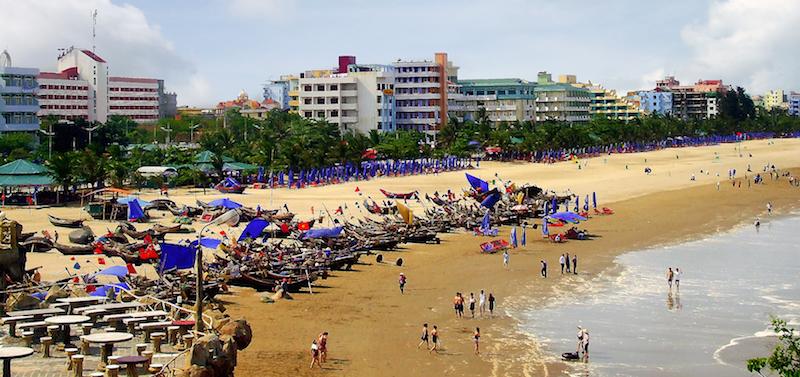
From Pho Chau, we set out early the next morning and had a long 176km drive north to Thanh Hoa city, the capital of Thanh Hoa Province. This was another overnight stop for us like Pho Chau as it’s not a place with a whole lot to offer and we wanted to press on to other destinations.
However, if you have plenty of time in Vietnam, the somewhat touristy Bien Sam Son beach is just nearby and the Ben En National Park is about 46km southwest of the city, boasting mountains, lush jungles and a big lake called Lake Song Muc, which is the park’s main attraction.
Ninh Binh City
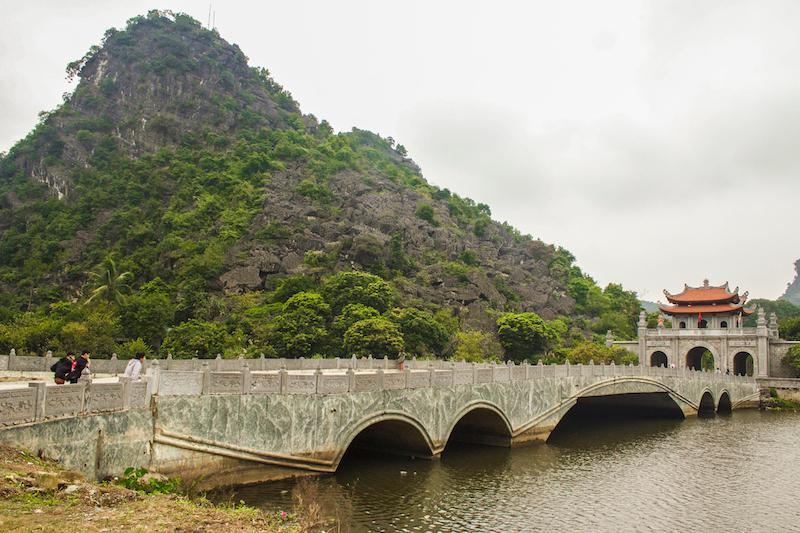
From Thanh Hoa, we had a relatively short drive of 70km to Ninh Binh city, the capital of Ninh Binh Province, located in a flat low-lying plain known as the Red River delta.
Ninh Binh is a place that has a lot to offer travellers so it’s definitely worth spending a few days here. The stunning karst landscapes to the west of the city are the biggest attraction here, with their soaring limestone rock pinnacles interspersed with emerald green paddy fields and winding rivers.
A few kilometres south of the city, you’ll find the Phat Diem Cathedral, which blends eastern and western architecture and is one of Vietnam’s most beautiful churches.
In Ninh Binh you can also visit the nearby ancient capital of Hoa Lu, which was the capital of Vietnam in the 10th and 11th centuries. It’s set among the stunning karst topography just west of Ninh Binh and is one of the most important sights here.
Today very little remains of the ancient citadel, but several beautiful monuments and temples have been built in honour of the emperors and their family members. A steep climb up the 200m high Ma Yen mountain here takes you up to the tomb of King Dinh and there are some good views of the surrounding karst landscape on the way up.
The Tam Coc rowboat journey is another highlight in Ninh Binh, which involves paying for a local person (usually a woman) to row you deep into a flooded karst landscape. The boat station is just to the southwest of the city. The rowers here usually use their two feet instead of their hands to propel the boat and during the course of the journey you’ll be rowed through three flooded tunnels that the river has carved out of the limestone mountains (Tam Coc means ‘three caves’).
Another very similar boating-through-caves experience can be had at the Trang-An grottoes, also found very close to Ninh Binh, and here there are more Vietnamese and Chinese tourists than western ones.
There’s also a fantastic cave pagoda nestled among the karst topography, called the Bich Dong Cave pagoda and half of the temple juts into a large cave behind it. You shouldn’t miss the opportunity to climb some of some of the limestone peaks here, with one of the most famous ones being Hang Mua peak found near Tam Coc.
Finally, the Cuc Phuong National Park is about 55km west of Ninh Binh. This was Vietnam's first national park and is the country's largest nature reserve. It's known for its well-preserved rainforest with ancient trees, caves, abundant butterflies and an endangered primate-rescue centre with around 150 animals, which apparently you must have a guide to visit.
Halong City
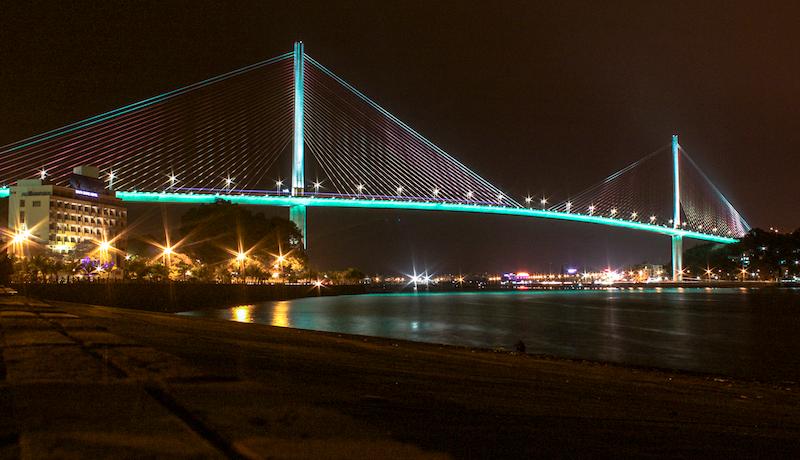
From Ninh Binh, we could have ended the journey and headed to Hanoi, just 110km away, but we wanted to visit Cat Ba Island, we found ourselves making another marathon 210km drive for Halong city, known locally as Bai Chay.
We finally reached the city after dark but had mistakenly crossed the Bai Chay bridge, thinking we would find all the guesthouses on the other side. We ended up having to backtrack across the enormous bridge, which spans the Cua Luc straits and allegedly holds the record for having the ‘world’s longest centre-span (435m) of any single-plane, cable-stayed, pre-stressed concrete bridge’.
We soon found an inexpensive guesthouse quite near to the bridge but that was about the full extent of our jaunt here, because we weren’t impressed with the place at all. Bai Chay is a gritty, overly industrialized city that we were all too happy to leave, almost as soon as we arrived.
Cat Ba Town
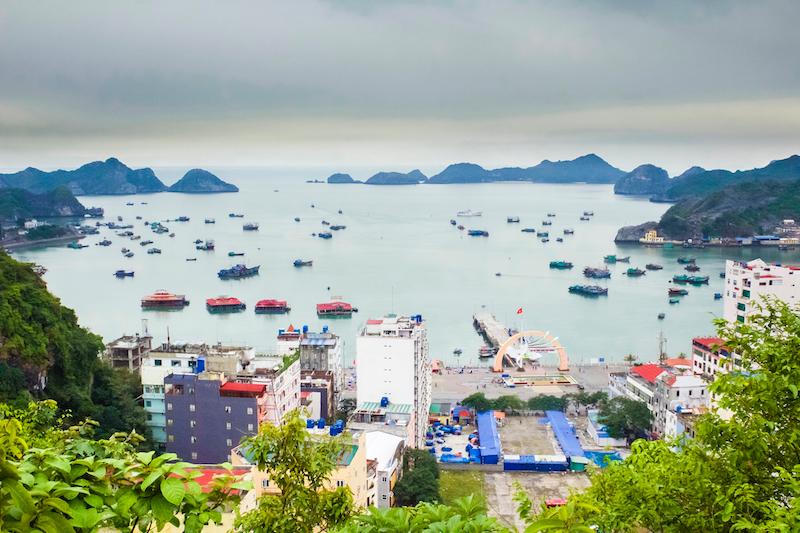
The next morning, we loaded up the motorcycle and drove out to the ferry terminal at the south end of Tuan Chau island. The island itself is only linked to mainland by a long, narrow road. From here we were able to load our motorbike onto a car ferry and make the spectacular crossing to Cat Ba Island. On the way to the island, the ferry sailed past dramatic limestone mountains that rose up out of the ocean, which is very shallow here with the deepest channels not exceeding 60 feet.
We docked at the main harbor at the north end of the island and now had a long drive 22km drive south to Cat Ba town at the opposite end of the island, where all the cheap guesthouses are to be found. We weren’t complaining about the drive though.
Cat Ba Island is incredibly scenic and feels like some kind of lost-world or a real-life Jurassic park. Covering an area of 350 square kilometres, it’s the largest island of the Cat Ba archipelago in Halong Bay.
The Karst topography here is really magnificent, especially when viewed from a high vantage point, with a repeating pattern of hundreds of cone-shaped limestone mountains cloaked in lush green vegetation, stretching as far as the eye can see.
As you might expect, there are plenty of caves to be explored here, although many of them will require local knowledge to find or access. The most obvious one is found beside the main road a few kilometres north of the town and is known as Hospital Cave, because it was used as a secret bombproof hospital and also as a safe-house for the Viet Cong leaders during the American War.
The island also offers an abundance of secluded coves and quiet beaches; three of them found just near the main town where all the guesthouses are. There are more beaches to be found in the south-west part of the island.
Don’t miss the Cat Ba National Park here whatever you do, where you can take an enjoyable hike up through the jungle, leading you uphill to a viewing tower and other vantage points, which all afford spectacular panoramic views of the Karst topography of the island. The park also harbours the highly endangered and golden-headed Cat Ba langur, which is a subspecies of the white-headed langur (Trachypithecus poliocephalus).
Another amazing thing to do here is kayaking among the flooded karsts and the many offshore islands, which you can do yourself by renting a kayak at the harbor near the village. We kayaked out to the famous monkey island, which only took about an hour. It’s a very small island with a gorgeous sandy beach and the possibility to climb to the top of a limestone pinnacle for outstanding views of the Lan Ha bay.
Hanoi

From Cat Ba town, we drove a very scenic coastal road leading to the Cai Vieng ferry terminal on the west side of the island. Along the way, we drove past picturesque and undisturbed beaches, mangroves and other scenic wonders. It was quite a long journey because the road was unfortunately in horrendous condition for many parts of the route.
At Cai Vieng we boarded a ferry and it brought us across a narrow stretch of water to the small Cat Hai island. We then drove the short distance to the west end of Cat Hai island and boarded another ferry at the Ninh Tiep ferry terminal which delivered us to Hai Phong city.
From Hai Phong city, we had a 120km drive to Hanoi, back again on the very busy and unpleasant roads of Vietnam. Finally rolling into Hanoi in the late evening we were absolutely ecstatic.
We had successfully completed our mission, driving over 2,000 kilometres from Ho Chi Minh city in the South and finally ending up at Hanoi in the North. We really couldn’t believe that we had pulled it off, despite having had virtually zero experience with riding motorcycles before we undertook the challenge. The entire trip had really been a dream come true.
Hanoi, the capital city of Vietnam, lies on the banks of the Red River and is the second largest city in the country (Ho Chi Minh is bigger). It’s definitely worth a visit, although like all overpopulated Vietnamese cities, you might only be able to take so much of the chaos. The motorcycle traffic here is really crazy, especially since many of the streets in Hanoi are so narrow.
Tourists mostly hang around the old quarter, attracted by the charming narrow streets, bustling markets, souvenir shops and restaurants.
Hanoi has several lakes and indeed is often referred to as ‘the city of lakes’. Hoan Kiem Lake (Lake of the returned sword) is the most attractive lake in the city that most visitors flock to and is the cultural and historical centre of the city. The atmosphere by the lake is especially magical during the golden hours.
At the lake’s north end, the beautiful red Huc Bridge leads out to the Temple of the Jade Mountain, located on a small island within the lake. The Turtle Tower or Thap Rua also sits on an islet in the lake and is illuminated at night time.
A legendary turtle that used to live in the lake, known as the Hoan Kiem turtle was pronounced dead at the beginning of 2016. The enormous turtle, 1.85m long and weighing 170kg, was considered sacred to the people and its believed that the turtle belongs to a highly endangered species of softshell turtle, which is also found in China.
Hanoi also has several beautiful pagodas worth visiting. The Tran Quoc Pagoda is the oldest Buddhist pagoda in the city and dates back to the 6th century. Other must see temples are the One-Pillar Pagoda and the Temple of Literature. The most interesting church in the city is St Joseph’s Cathedral with its fascinating neo-gothic architecture.
In Hanoi you can also visit the Ho Chi Minh presidential palace complex, explore the botanical gardens, watch a water-puppet show in the Thang Long Water Puppet Theatre, visit several interesting museums, sample the delicious street food and entertain yourself in many other ways.
How do I navigate my way?
%20(1).jpg)
As regards finding your way, you should get an unlimited data local SIM card so that you can access google maps on your phone whenever you’re confused about where to go next.
Vinaphone do a 1 month unlimited data plan for just 100,000 VND. You can also download areas on Google maps while you're online and still view them later while offline.
Google maps will be more reliable than a road-map as it will give you more up-to-date information on roads. You should still take a road-map however as a backup in case your battery dies and as an additional source of information. The more tools in your toolbox, the better.
In addition, you should download a free app called maps.me to your smartphone. This maps app is extremely useful for travellers because it works offline and is surprisingly accurate when it comes to roads and even off-road tracks.
Another similar app is citymaps2go, which allows you to download one free map for offline use. You can download the entire country of Vietnam for free if you've never downloaded a map before.
Pay attention to road signs also, especially at important junctions and forks in the road. Also pay attention to the small concrete markers along the sides of the road. Although the names of random, minor towns and villages tend to pop up all the time on these markers, sometimes your destination will pop up on one, allowing you to breathe a sigh of relief, knowing you're on the right road.
Ask for help from local people also. However, ask at least five different people for directions as you will often be given the wrong directions. Whether this is usually due to the language barrier or genuinely uninformed people, we’re not entirely sure. We hope it's the former.
If nothing else works, just bring a compass and try to keep heading in a north/south direction, depending on which city you start from.
Just bear this in mind folks. We did this entire trip without any help from technology. We didn't consult google maps or any maps apps. We didn't use our mobile phones at all to help us navigate from A to B. We used nothing but a terrible road map, which was so lacking in detail that it was as good as useless. So don't worry too much about navigation.
Where do I sleep?
On each day of riding, you should aim to reach a reasonably large town or city by the end of the day to ensure you have a variety of accommodation options to choose from. Arrive too late in the night however and many hotels may be closed, as happened to us when we reached Pleiku city (we had to spend the night on the street), so try not drive too far in one day.
Vietnam's towns and cities always have a few hotels and guesthouses, so don't worry about being able to find a place to stay. Some towns and cities even have hostels with dormitories.
Inexpensive guesthouses are advertised by the words 'Nha Nghi' (pronounced 'Nya Knee') and most towns have several of them. Some have Wifi, some do not.
The lowest we paid during our trip for 1 night's accommodation in a double room was 100,000 dong ($4) and the highest was about 150,000 ($6).
Is it a dangerous undertaking?
There's no denying that this is a pretty risky undertaking, regardless of how skilled a driver you are.
Road accidents are the leading cause of fatalities in Vietnam due to the country's high traffic density, killing about 14,000 people every year - 30 times the number of people killed by pandemic diseases. Half of the people that die are motorcyclists, so you are definitely at risk.
Large buses and trucks trundle down the roads at breakneck speeds, overtaking everything in their way, honking their horns repeatedly and sometimes forcing oncoming vehicles off the road, into the ditches.
Road rules are seemingly not adhered to very often. This can make the traffic a little more chaotic and unpredictable, but you do get used to it after a few days driving the roads. There's method in the madness.
Certain stretches of road are also in horrible condition, peppered with large potholes or not yet sealed. You’ll sometimes have to drive over gravelled stretches, muddy stretches and even rocky stretches (they’re a lot of fun).
In rural village scenarios, chickens, ducks, dogs, cows, water buffaloes, pigs, goats and other domestic animals regularly dash out across the road as you approach, meaning that you might need to brake suddenly to avoid a collision.
You can adapt to these circumstances and reduce the risk considerably by following a few golden rules. Avoid driving at night, drive slowly at almost all times, always stay attentive and alert to the road ahead and check your mirrors regularly for large vehicles approaching from behind.
If you do drive at night, drive very slowly, because potholes often only become visible at the last second and you need to give yourself time to avoid them - time that you don't have if you're driving too fast. Full-beam headlights of oncoming traffic can also dazzle you while driving at night and make it very difficult to see the road ahead.
A lot of travellers do have minor accidents, mostly caused by overconfidence, driving too fast, driving at night or inexperience.
Many backpackers somehow manage to badly burn their leg on the hot exhaust pipe of the bike (known as a Vietnamese tattoo). It's a good idea to take a small first-aid kit to deal with mishaps like this. Buy a special cream for treating burns and take some larger plasters too. You should be able to avoid becoming another statistic by following the advice we’ve given you.
Will refuelling ever be a problem?
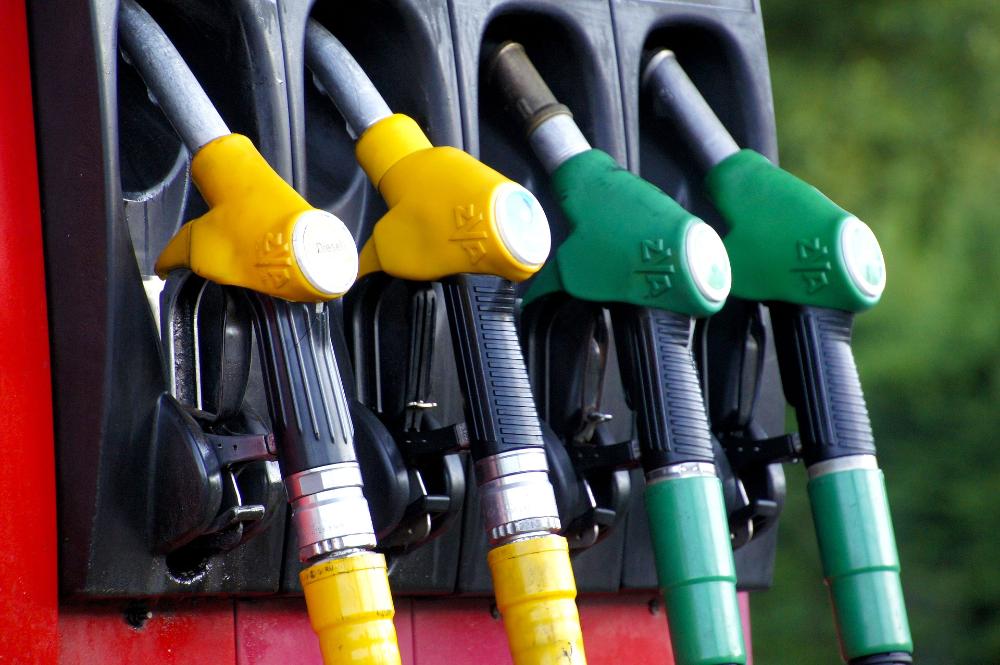
Generally, no. There are plenty of petrol stations along the way and you’ll rarely drive more than 50 km without passing one.
Petrol is also readily available from many ordinary houses and shops along the side of the road so it’s rarely a crisis if you run out of petrol a long way from the nearest station.
People will also help you out and bring you petrol from afar if you run out in the middle of nowhere, as we learned from a few of our experiences. We couldn't believe how obliging the Vietnamese people were in these scenarios!
With that said, it’s still no harm to carry a spare litre or two with you inside a plastic bottle stowed away inside the storage compartment beneath the seat, just in case. This is actually one of our top travel safety tips.
There is one notable stretch of the journey on the Ho Chi Minh Road, where you likely will need to carry your own fuel. This is the 240km stretch between Khe Sanh and Xuan Son and during this stretch there is only one gas station and very little development whatsoever.
One piece of advice we'd give you is to be careful with people overcharging you for petrol. You should also be aware of the petrol refuelling scam that often occurs in Vietnam.
What should I know about repairs and maintenance?
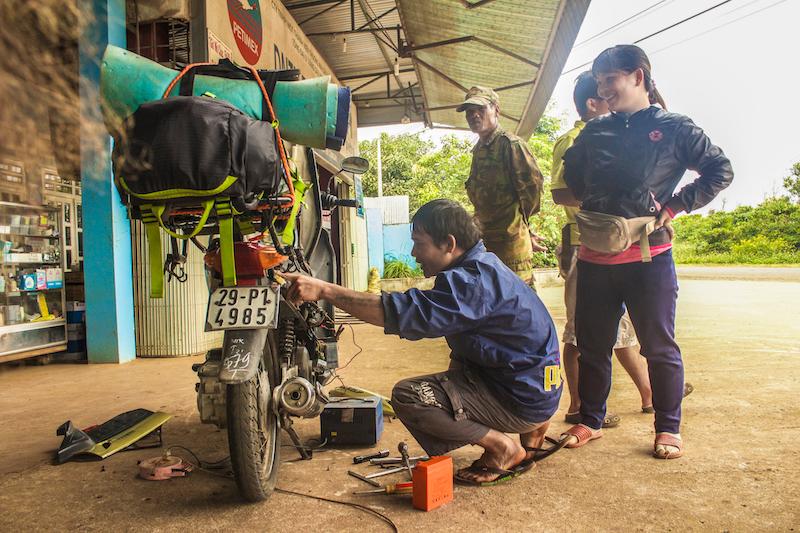
Regarding maintenance, the main thing you need to remember is to change the oil every so often. We were advised to change the oil every 500km or so, but in all honesty we’re not really sure if that was good advice or not. If you don’t know how often the oil should be changed, it’s probably best to go with the recommendation of the person you buy the bike from.
You should also try to keep your tyres from getting too soft by filling them with air every few hundred kilometres. If you’re driving a manual bike, you may also need to have the chain re-tensioned every so often.
Regarding repairs, you may run into a number of issues including a busted battery, tyre punctures, malfunctioning headlights, broken mirrors, malfunctioning fuel gauge, ignition problems, a broken luggage rack and other serious issues like squeaking gearboxes and damaged internal electric components. We know because we experienced virtually every problem in existence with our motorbike, which was in horrendous condition when we bought it.
Whether it’s for repairs or maintenance, the go-to place is always one of the thousands of mechanic shops found throughout Vietnam. They’re found just about everywhere, from the tiny non-descript villages to the bigger cities. The words you’re looking for are sua chua xe may (motorcycle repair shop) or just the words xe om or xe may, which both mean 'motorbike'.
Be careful with mechanics trying to overcharge you, especially in towns that are used to seeing tourists. If something seems too expensive, then you’re probably being overcharged. Mechanics are way, way cheaper in Vietnam than they are in western countries. A brand new battery for example only costs about $10-12 and a puncture repair only costs about $0.75. An inner tube replacement should cost around $3-5, depending on the quality of the tube.
Will the police be an issue?
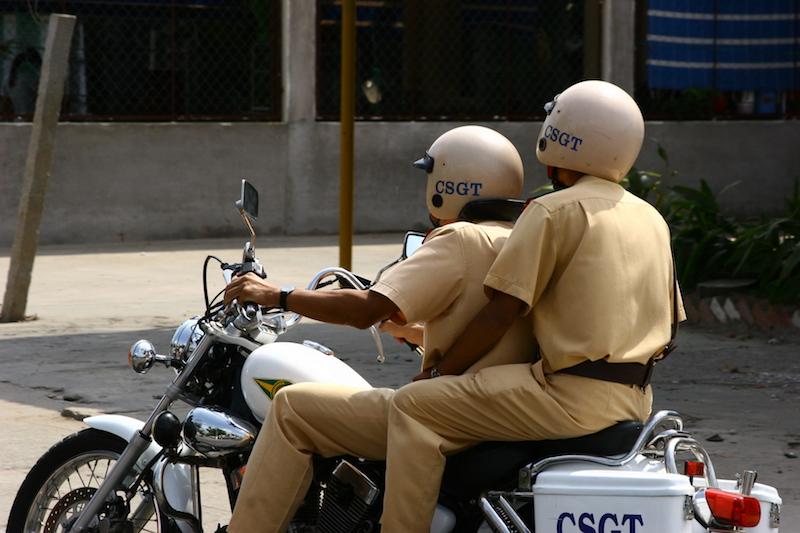
Generally, no the police won’t be a problem and will usually leave you alone. They’ll usually ignore you at ordinary checkpoints, perhaps because of the language barrier.
Remember also that the more you blend in with the local people, by wearing similar clothing, dust masks and driving a semi-automatic or automatic bike, the less attention you’ll attract from the police.
Make sure also that you're not breaking any major rules when you're driving to avoid run-ins with the police. Not wearing a helmet, undertaking (overtaking on the kerb side), breaking red lights and driving with more than two people on a motorcycle are all illegal.
Try to carry a driving license of some sort, even a fake one, because not carrying one is illegal too. Ideally, you'd have an international driver's permit, but who wants to go through the hassle of getting one of those?
Try to also keep your speed under 60km/h on main roads and below 30km/h when you're cruising through towns and villages so the police don't have any excuse to fine you or confiscate your bike.
We only had one incident with the police near Mui Ne, where they had deliberately set up a trap for foreign tourists, in order to fine them for 'speeding' or for not carrying their driver’s licenses. They had no speed cameras set up and no proof that anybody was speeding but were pulling people over and fining them regardless.
If you get stopped by a police officer, it’ll usually be an attempt to steal your money and rarely for any genuine offence. There are a few tactics you can try to avoid paying a fine:
-You can try to pretend not to understand the officer until he finally gives up trying to communicate to you and lets you go.
- You can politely refuse to pay the fine and stand your ground until the officer gradually reduces it down to a reasonable amount (they’ll often initially ask for 50$ or more). Using this tactic we managed to reduce our fine from 50$ down to just 4$.
Be careful with an outright refusal to pay the fine as the police may confiscate your bike and/or take you to the police station.
Should I have travel insurance?
This is a debatable topic. We have been travelling Southeast Asia and India continuously for almost 3 years without travelling insurance and we have never had anything catastrophic happen that made us regret not having travel insurance.
However, if you find that you cannot achieve peace of mind without travel insurance, then it might be worth it for you, even if buying insurance is rarely an economically sound choice.
The reality is that if you do have a serious accident, the medical care in most parts of Vietnam will not be sufficient. You will probably have to be evacuated and that cause you financial ruin if you don't have insurance.
If you do take out travel insurance, you should also have an international driver's license as companies won't pay out if you were driving illegally. There may be loopholes or ways to circumvent this though, so do your due research.
How do I sell the motorcycle after I complete the journey?
To sell the bike as quickly as possible after finishing your trip, you’ll want to exploit all of the available avenues for advertising the bike. The main ones are:
Internet
Make a bike-for-sale ad on craigslist a few days before you arrive in your final destination. Give the bike a good wash and then take a few decent photographs of the bike from different perspectives. Put some effort into your listing and give as much information as possible about the bike. Offer a fair price and then let the ad work its magic. You’ll probably be contacted very soon by potential buyers. This was the method we used to sell our bike to a Russian couple.
Leave ads in backpacker hostels
Make an attractive looking ad for your bike on an A4 sheet of paper and print out dozens of copies. Use huge, bold, attractive fonts to draw people’s attention. Stick your ad to the noticeboards inside as many backpacker hostels as you can find and then wait patiently for an offer. You’ll likely be competing with other ads on the same noticeboard so make sure your ad is really eye-catching.
Drive or walk around backpacker areas
If you’ve no time to wait for people to contact you, then you’ll want to try a more active approach. Make a large sign saying ‘motorbike for sale’ and tape it/fix it to your t-shirt somehow and walk around the busy backpacker areas.
Approach people and ask them if they’re looking to buy a bike or if they know anybody that is. Hang around the most popular/busiest backpacker hostels and ask every backpacker you see. This is a very effective method and will usually get you a sale very quickly. We had several interested buyers after trying this for just a few hours.
Attach a sign to the bike
The bike might as well be recruiting potential buyers for you whenever you leave it unattended or parked. Fix a ‘for sale’ sign to the bike with sticky tape and make sure to include your contact information.
By all means you should try to make a profit or at least recoup what you paid for the bike initially. This will of course be easier to do if you got a great deal when you bought the bike, which is more likely if you started your trip in Hanoi.
However, if time is running out and nobody seems to be biting on your offer, you'll have to reduce the price substantially in order to sell it before your flight or visa expiry. You’ll make a loss but that's just life sometimes.
Final thoughts
Driving the full length of Vietnam on a motorcycle is no doubt a challenging endeavour and one that certainly requires an ample dose of courage. It is somewhat risky and the roads can be downright dangerous at certain times. However, the sheer sense of accomplishment and the amount of personal growth that you'll experience from undertaking an adventure like this, far outweighs the risks, as far as we're concerned.
If two complete novices like us can successfully complete the journey in one piece, then as far as we're concerned, virtually anybody in good health can do it also. It just takes a bit of courage, determination and perhaps a little sprinkling of blind faith.
Watch video:
You can watch all of our Vietnam videos here.
Recommended Guidebook: Lonely Planet Vietnam
We hope you enjoyed reading the guide and found it helpful. Please share it with other travellers and give us your feedback below. Have you ever completed an epic motorcycle journey like this? We'd love to hear your story.
JOIN OUR LIST
SUPPORT US
FOLLOW US
ABOUT US
Our names are Eoghan and Jili and we hail from Ireland and India respectively.
We are two ardent shoestring budget adventure travellers and have been travelling throughout Asia continuously for the past few years.
Having accrued such a wealth of stories and knowledge from our extraordinary and transformative journey, our mission is now to share everything we've experienced and all of the lessons we've learned with our readers.
Do make sure to subscribe above in order to receive our free e-mail updates and exclusive travel tips & hints. If you would like to learn more about our story, philosophy and mission, please visit our about page.
Never stop travelling!
FOLLOW US ON FACEBOOK
FOLLOW US ON PINTEREST
-lw-scaled.png.png)


